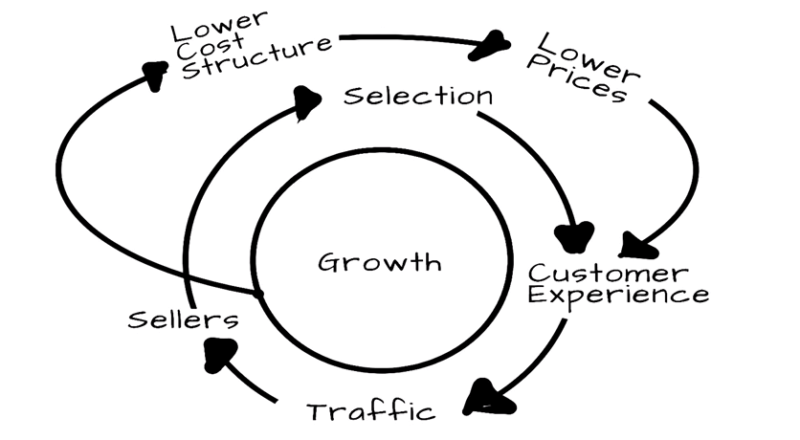How 3 SEO strategies built today’s eCommerce giants
Learn how third-party sellers, backlinks and a clearly defined niche can leverage SEO opportunities.
Today, we’ll approach the answer to that question through the lens of SEO. Why are today’s top e-commerce sites doing so well in the search engines, and what can we learn from them?
Focusing on catalog size and third-party sellers
Amazon is dominating the e-commerce landscape for many reasons, but one underreported factor is simply how extensive its catalog is when compared to other online retailers. One of the reasons Amazon’s catalog is so massive is because of their third party sellers.
In fact, as of Q1 in 2018, product units sold by third-party sellers make up 52 percent of the sales volume on Amazon.
 In 2017, those sales accounted for a staggering $31.88 billion in revenue, a very significant portion of Amazon’s $178 billion in revenue for the year.
In 2017, those sales accounted for a staggering $31.88 billion in revenue, a very significant portion of Amazon’s $178 billion in revenue for the year.
Offering a massive selection has always been core to Amazon’s strategy, a crucial part of what they internally called The Virtuous Cycle. [YouTube link is to Amazon’s “Inside Amazon Videos” YouTube channel for employees.]
The Virtuous Cycle was first drawn on a napkin by Jeff Bezos, and it looks like this:
 Third party sellers were always a crucial part of Amazon’s business model, a way of increasing selection and ultimately reducing prices in turn. This created a flywheel effect that allowed the company to grow to its massive size today.
Third party sellers were always a crucial part of Amazon’s business model, a way of increasing selection and ultimately reducing prices in turn. This created a flywheel effect that allowed the company to grow to its massive size today.
From an SEO perspective, offering a massive catalog selection means targeting far more queries. The more brands you offer for sale, the more brands you will rank for. The more products you offer, the more long tail traffic you will capture.
By making product selection a core aspect of Amazon’s business model, Amazon has come to dominate online sales, accounting for a staggering 43 percent of online retail sales.
Does this mean that every e-commerce site hoping to expand their search traffic should shift all of their attention to expanding their product catalog and start opening up their doors to third-party sellers? Certainly not. Making this the primary goal could fundamentally compromise other business goals and even your unique selling proposition.
Nevertheless, catalog size is an important area of growth all e-commerce sites should be mindful of. In addition to general growth in product selection, competitors can focus on more niche ways to grow, such as expanding their selection to include exclusive or unique products. But the SEO lesson is the same: there’s a limit to how many queries you can target when your product selection itself is limited.
Earning links off of others’ self-interest
Amazon may get the most media coverage, but eBay has a long history of success, and it’s still the second most successful American online retailer in terms of revenue, bringing in roughly nine billion dollars per year.
Despite arriving on the scene a year after Amazon, eBay was able to make a name for itself by taking Amazon’s concept of third-party sellers even further. As most of you are well aware, eBay is a platform built entirely on third-party sellers, a place for people to bid on items sold by other users. The platform has since expanded to include bid-free purchases and top sellers have grown from garage sale operations to full-fledged businesses.
While Amazon is a much bigger company, eBay is beating Amazon on one important SEO metric, the number of backlinks. According to SEMrush, the Amazon.com domain has earned about 2.7 billion backlinks:
 While eBay has earned 4.8 billion:
While eBay has earned 4.8 billion:
 Make no mistake, Amazon still has more referring domains, and they certainly aren’t losing sleep over this metric, but the fact that eBay, a company with far less revenue, has managed to earn more backlinks means they are doing something right.
Make no mistake, Amazon still has more referring domains, and they certainly aren’t losing sleep over this metric, but the fact that eBay, a company with far less revenue, has managed to earn more backlinks means they are doing something right.
Why so many backlinks? Simple. Sellers have a reason to link to their pages and auctions and to update those links regularly when new auctions go up.
For evidence of this, all you need to do is look at the anchor text for those inbound links:
 Bare URLs and “buy it now” links are a strong indicator that most of these links are being put up by sellers linking to their auctions.
Bare URLs and “buy it now” links are a strong indicator that most of these links are being put up by sellers linking to their auctions.
The story is much the same for Etsy, another site that works as a platform for sellers:
 The strategy has earned them a sizable 105 million backlinks, with a number of referring domains comparable to eBay:
The strategy has earned them a sizable 105 million backlinks, with a number of referring domains comparable to eBay:
 Of course, not every e-commerce site can be a platform for third-party sellers to promote themselves, but there is a deeper lesson here than merely copying eBay’s core business strategy. The people who have a business motivation to link to you are the people who are most likely to do so.
Of course, not every e-commerce site can be a platform for third-party sellers to promote themselves, but there is a deeper lesson here than merely copying eBay’s core business strategy. The people who have a business motivation to link to you are the people who are most likely to do so.
This means that any e-commerce site that acts as a retailer for manufacturers and brands should reach out to those business partners and encourage them to promote their listings on your site on their platforms. You can help make this easy for them by providing them with product listing embeds, social media posting tools, “buy now” buttons and similar tools.
Beyond that, the question “how can linking to us benefit them” is vital and deserves a unique solution built around your business model and brand. Approach this question strategically and you will blow your competition out of the water.
A clearly defined niche
We mentioned Etsy above because they share a strategy with eBay: acting as a platform for sellers and earning automatic promotion as a result. But Etsy arrived a decade after Amazon and eBay, both of them also appealing to third-party sellers. Etsy’s success required another ingredient: a focus on their niche.
Make no mistake, Etsy is highly successful. If we set aside Walmart and focus strictly on online retail sites, Etsy is the third most successful in terms of US traffic. Its growth in revenue has also been remarkably consistent, currently approaching half a billion annual dollars:
 Etsy owes that success to a clearly defined unique selling proposition. Amazon and eBay are places to buy anything. Etsy, on the other hand, is a place to buy strictly “from creative people everywhere” as it currently states in their homepage title tag.
Etsy owes that success to a clearly defined unique selling proposition. Amazon and eBay are places to buy anything. Etsy, on the other hand, is a place to buy strictly “from creative people everywhere” as it currently states in their homepage title tag.
It is against the rules of the site to sell mass-produced goods, meaning that each product is unique and sellers start to take on personality and personal brands as artists and craftspeople.
How has this impacted their SEO?
According to SEMrush, Etsy attracts roughly 49 million in search traffic. Looking at the keywords they are ranking for, we can see why they are able to carve out a space for themselves in the search landscape against Amazon and eBay:
 While the other e-commerce giants have no trouble ranking on the front page for mass-produced goods, items like these are much more appealing if they are hand-crafted and unique. Etsy is able to reasonably dedicate an entire site category to keychains:
While the other e-commerce giants have no trouble ranking on the front page for mass-produced goods, items like these are much more appealing if they are hand-crafted and unique. Etsy is able to reasonably dedicate an entire site category to keychains:
 Amazon ranks further down the front page of Google, likely because they can only list a product, rather than a comprehensive keychain category page:
Amazon ranks further down the front page of Google, likely because they can only list a product, rather than a comprehensive keychain category page:
 By defining a much narrower niche, Etsy is able to outrank a much larger, more authoritative site for select queries. In this way, it is able to find a place in the search results despite (and because of) its market position.
By defining a much narrower niche, Etsy is able to outrank a much larger, more authoritative site for select queries. In this way, it is able to find a place in the search results despite (and because of) its market position.
If you want to succeed like Etsy, an e-commerce site late to the party, you need to consider what your unique selling proposition is and how that ties into your SEO opportunities.
You can’t necessarily offer a larger product selection than Amazon, but you can offer a larger product selection within a specific category. You can’t necessarily earn more third-party sellers than eBay but you can attract more third-party sellers within a specific industry.
Have you identified which categories you offer a more diverse selection in than other e-commerce sites? If so, you should build dedicated pages for those, optimize and promote them, and you will have a very good chance of outranking the other sites for those categories.
Conclusion
While the overwhelming dominance of a few players in the e-commerce industry is unlikely to change, hundreds of billions of dollars are still in the market for smaller players and we can learn from the biggest winners in this industry as long as we have the vision to strike out our own path.





